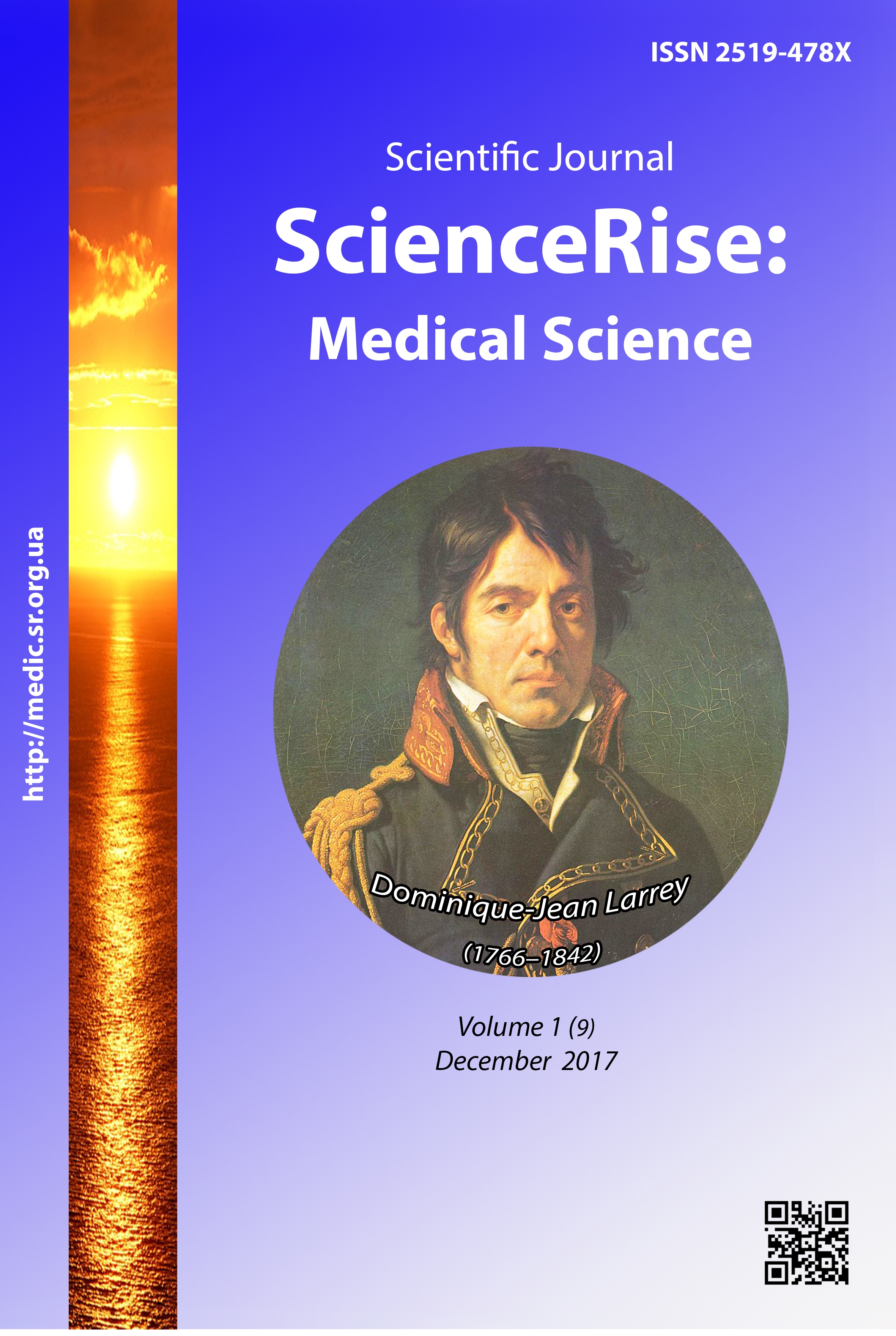Non-traumatic subarachnoid haemorhage: clinical onset symptoms as predictors for patients` clinical outcome
DOI:
https://doi.org/10.15587/2519-4798.2017.91507Keywords:
subarachnoid haemorhage, saccular aneurysm, computer tomography/angiography, Glasgow Outcome ScaleAbstract
Aim. In this article, we tried to find out whether any of SAH clinical symptoms can be both short-term and long-term predictors for patients.
Materials. 144 SAH / unruptured aneurysm patients, treated at Uzhgorod Regional Center of neurology and neurosurgery during 4 years, were examined. The patients were examined on standardized scales (WFNS, Hunt-Hess, GCS), neurovisual and other clinical criteria. The early clinical outcome was determined by GlasgowOutcomeScale.
Results and discussion. Considering the given clinical data, we can identify several predictors of a positive early outcome after aneurismal subarachnoid hemorrhage (i.e. 4 – 5 Glasgow Outcome Scale points):
- High level of consciousness, according to the GSC scale, at the moment of hospitalization;
- Hunt-Hess / WFNS I-II.
At the same time, low indicators of these scales in the disease onset are associated with a worse early outcome (1 – 3 Glasgow Outcome Scale points).
The young age is SAH risk factor, but it’s not the unambiguous feature for the disease prediction.
Also, a hypertension in anamnesis is one of the worse prediction indexes.
Conclusion. A correlation between epileptic seizures in SAH onset and higher risk of rebleeding was found out. Therefore, this clinical symptom can be a negative outcome predictor and requires more thorough attention and study.
We believe that even patients with good neurological recovery and the relative / complete independence after SAH in future can suffer from anxiety, depression, post-traumatic stress disorder and cognitive impairment, affecting quality of their lives. It should be considered in the long term – with cognitive function study and the use of quality of life scale in routine practice after SAH
References
- Dikmen, S. S., Heaton, R. K., Grant, I., Temkin, N. R. (1999). Test-retest reliability and practice effects of Expanded Halstead-Reitan Neuropsychological Test Battery. Journal of the International Neuropsychological Society, 5 (04), 346–356. doi: 10.1017/s1355617799544056
- Feigin, V. L., Rinkel, G. J. E., Lawes, C. M. M., Algra, A., Bennett, D. A., van Gijn, J., Anderson, C. S. (2005). Risk Factors for Subarachnoid Hemorrhage: An Updated Systematic Review of Epidemiological Studies. Stroke, 36 (12), 2773–2780. doi: 10.1161/01.str.0000190838.02954.e8
- van Gijn, J., Kerr, R. S., Rinkel, G. J. E. (2007). Subarachnoid haemorrhage. The Lancet, 369 (9558), 306–318. doi: 10.1016/s0140-6736(07)60153-6
- van Gijn, J., Rinkel, G. J. (2001). Subarachnoid hemorrhage: diagnosis, causesand management. Brain, 124, 249–278.
- Hackett, M. L., Anderson, C. S. (2000). Health outcomes 1 year after subarachnoid hemorrhage: An international population-based study. Neurology, 55 (5), 658–662. doi: 10.1212/wnl.55.5.658
- Pegoli, M., Mandrekar, J., Rabinstein, A. A., Lanzino, G. (2015). Predictors of excellent functional outcome in aneurysmal subarachnoid hemorrhage. Journal of Neurosurgery, 122 (2), 414–418. doi: 10.3171/2014.10.jns14290
- Kowalski, R. G. (2004). Initial Misdiagnosis and Outcome After Subarachnoid Hemorrhage. JAMA, 291 (7), 866. doi: 10.1001/jama.291.7.866
- Longmore, M., Wilkinson, I., Turmezei, T., Cheung, C. K. (2007). Oxford Handbook of Clinical Medicine. Oxford University Press, 892.
- Noble, A. J., Baisch, S., Schenk, T., Mendelow, A. D., Allen, L., Kane, P. (2008). Posttraumaticstress disorder explains reduced quality of life in subarachnoidhemorrhage patients in both short and long term. Neurosurgery, 63 (6), 1095–1105. doi: 10.1227/01.neu.0000327580.91345.78
- Ravnik, J., Starovasnik, B., Pirtosek, S., Bunc, G. V., Bosnjak, R. (2006). Long-term cognitive deficits in patients with good outcomesafter aneurysmal subarachnoid hemorrhage from anterior communicatingartery. Croat Med J, 47 (2), 253–263.
- Rosen, D. S., Macdonald, R. L. (2005). Subarachnoid Hemorrhage Grading Scales: A Systematic Review. Neurocritical Care, 2 (2), 110–118. doi: 10.1385/ncc:2:2:110
- Suarez, J. I., Tarr, R. W., Selman, W. R. (2006). Aneurysmal subarachnoid hemorrhage. New England Journal of Medicine, 354 (4), 387–396.
- Anderson, P. (2013). Tool Helps Rule Out Bleeds in Acute Headache. Medscape Medical News, 127–129.
- Newman-Toker, D. E., Edlow, J. A. (2013). High-Stakes Diagnostic Decision Rules for Serious Disorders. JAMA, 310 (12), 1237. doi: 10.1001/jama.2013.278019
- Perry, J. J., Stiell, I. G., Sivilotti, M. L. A., Bullard, M. J., Hohl, C. M., Sutherland, J. et. al. (2013). Clinical Decision Rules to Rule Out Subarachnoid Hemorrhage for Acute Headache. JAMA, 310 (12), 1248. doi: 10.1001/jama.2013.278018
- Vilkki, J. S., Juvela, S., Siironen, J., Ilvonen, T., Varis, J., Porras, M. (2004). Relationship of Local Infarctions to Cognitive and Psychosocial Impairments after Aneurysmal Subarachnoid Hemorrhage. Neurosurgery, 55 (4), 790–803. doi: 10.1227/01.neu.0000137629.17424.6d
- Visser-Meily, J. M. A., Rhebergen, M. L., Rinkel, G. J. E., van Zandvoort, M. J., Post, M. W. M. (2008). Long-Term Health-Related Quality of Life After Aneurysmal Subarachnoid Hemorrhage: Relationship With Psychological Symptoms and Personality Characteristics. Stroke, 40 (4), 1526–1529. doi: 10.1161/strokeaha.108.531277
Downloads
Published
How to Cite
Issue
Section
License
Copyright (c) 2017 Євгенія Іванівна Цьома, Володимир Іванович Смоланка, Юрій Юрійович Чомоляк, Тарас Олександрович Студеняк

This work is licensed under a Creative Commons Attribution 4.0 International License.
Our journal abides by the Creative Commons CC BY copyright rights and permissions for open access journals.
Authors, who are published in this journal, agree to the following conditions:
1. The authors reserve the right to authorship of the work and pass the first publication right of this work to the journal under the terms of a Creative Commons CC BY, which allows others to freely distribute the published research with the obligatory reference to the authors of the original work and the first publication of the work in this journal.
2. The authors have the right to conclude separate supplement agreements that relate to non-exclusive work distribution in the form in which it has been published by the journal (for example, to upload the work to the online storage of the journal or publish it as part of a monograph), provided that the reference to the first publication of the work in this journal is included.









